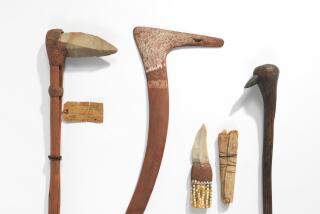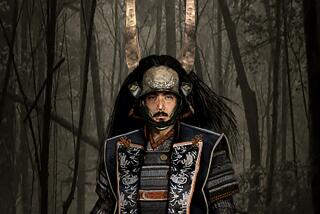Artifacts of devotion
Although it focuses on popular festival traditions, the multifaceted “Matsuri!” exhibition at the UCLA Fowler Museum also provides a cogent overview of Japanese theatrical idioms and their relationship to folklore.
Indeed, near the end of the Fowler exhibition, you’ll find the masks of two characters that also are on view at the very beginning of the concurrent “Miracles and Mischief” Noh exhibition at the Los Angeles County Museum of Art. These masks (one white, one black) depict Okina and Sambaso, dancing archetypes that link religion, the daily life of the common people and the stage. LACMA’s presentation doesn’t attempt to cover that wide a conceptual range, but the Fowler’s does -- and succeeds.
Besides artifacts of Noh drama, the Fowler provides a graceful bunraku puppet, ornate Kabuki costumes and a mannequin dressed in spectacular Bugaku court regalia. But there’s plenty of theatricality in the nontheatrical apparel as well -- in a 19th century cotton fireman’s coat, for instance, painted with a scene from the Noh classic “The Monstrous Spider.”
Equally dramatic, a cotton fisherman’s robe from between the 17th and 19th centuries offers painted abstractions of sea creatures along with a realistic (and enormous) red lobster, while an assortment of printed headbands draws inspiration from such subjects as masks, sumo wrestlers and Matsuri processions.
All the artifacts play a part in Matsuri festivals -- joyously chaotic Shinto-Buddhist events marked by extraordinary dress, extravagant entertainment and sacred chants. (Matsuri means “to offer worship.”)
Numerous photographs and some video monitors reinforce the role of Matsuri events in Shinto and Buddhist practices -- mostly as offerings to the deities and celebrations of prosperity. Prayer banners are at once an act of devotion and a public display, just as the design motifs on many informal Matsuri coats and robes are boldly decorative in themselves and identify the wearers as members of shrine community groups.
Often blue and white, with patterning derived from ocean waves, wisteria vines or chrysanthemums, festival coats and robes form the core of the exhibition and showcase arcane decorative techniques. (Curator Gloria Granz Gonick surveys the varied approaches at length in her published catalog.) Many are antiques, but plenty of exceptions dramatize Matsuri as a living tradition.
Look closely at a circle of seven dancing mannequins, and you’ll notice that some of their paddle fans are plastic and printed with photographic images clearly influenced by contemporary advertising graphics. Note also that a mannequin dressed as a deer dancer wears costume components dating from 1868 to 2000.
Some of the most gorgeous costumes are patchworks: pieces of worn-out heirlooms recycled by being sewn onto new fabric. This collage of past and present typifies the Japanese festivals and the Fowler’s illuminating tribute to them.
*
‘Matsuri: Japanese Festival Arts’
Where: UCLA Fowler Museum of Cultural History, UCLA campus, Westwood
When: Wednesdays-Sundays, noon to 5 p.m. Thursdays, noon to 8 p.m. Closed Mondays and Tuesdays
Ends: Feb. 9
Price: Exhibition free; parking, $7
Contact: (310) 825-4361
More to Read
The biggest entertainment stories
Get our big stories about Hollywood, film, television, music, arts, culture and more right in your inbox as soon as they publish.
You may occasionally receive promotional content from the Los Angeles Times.










